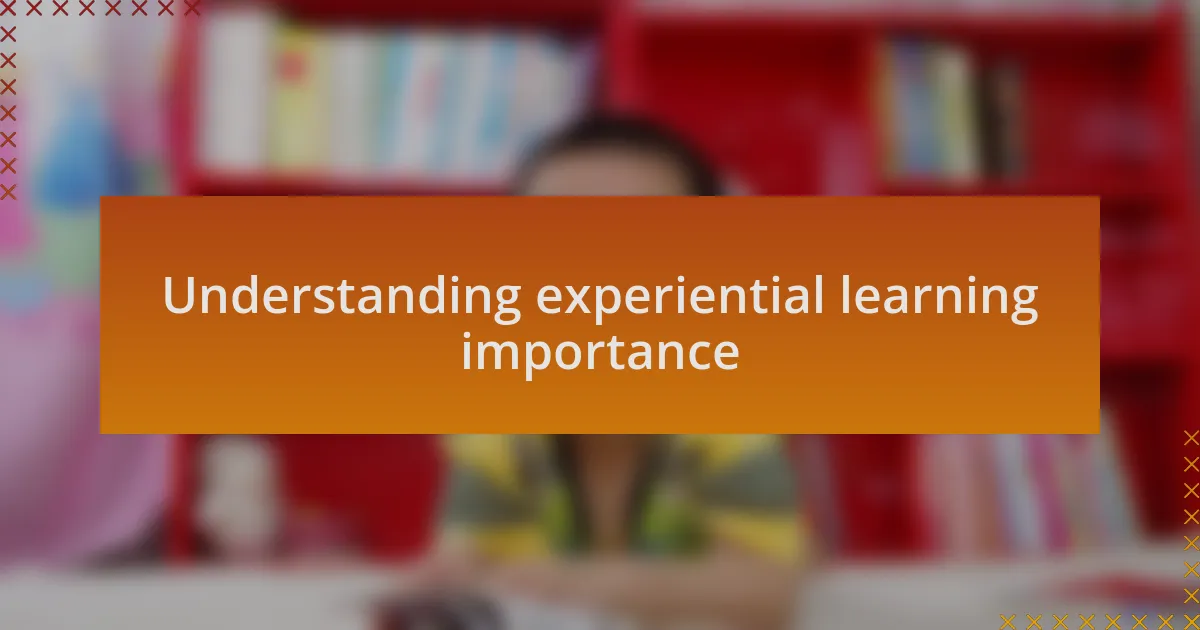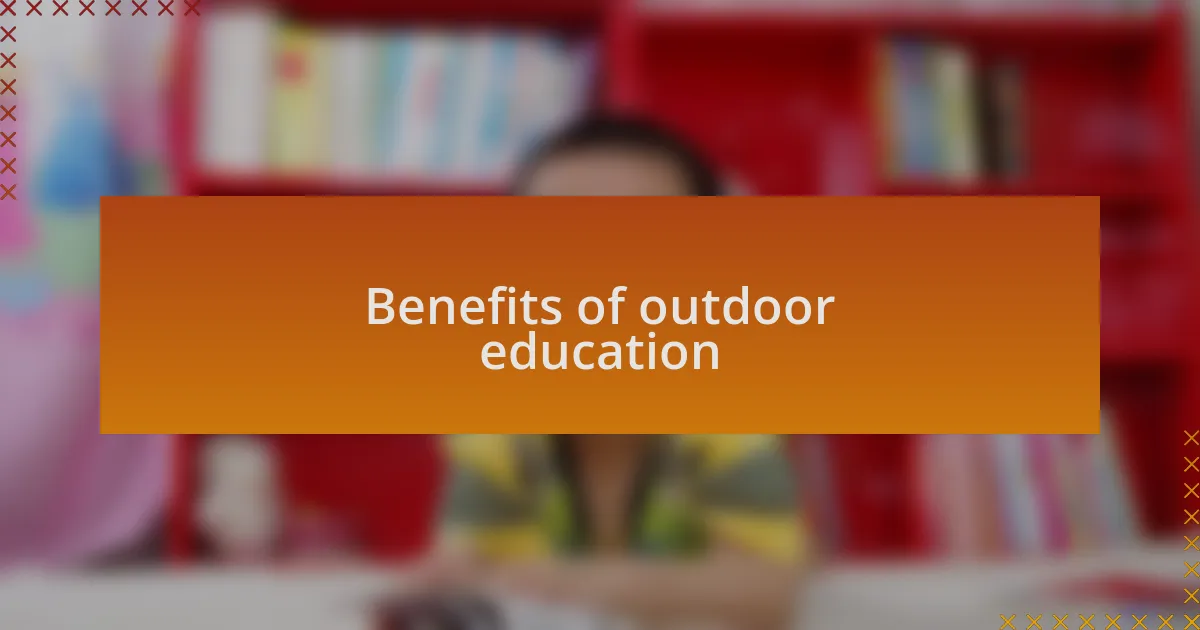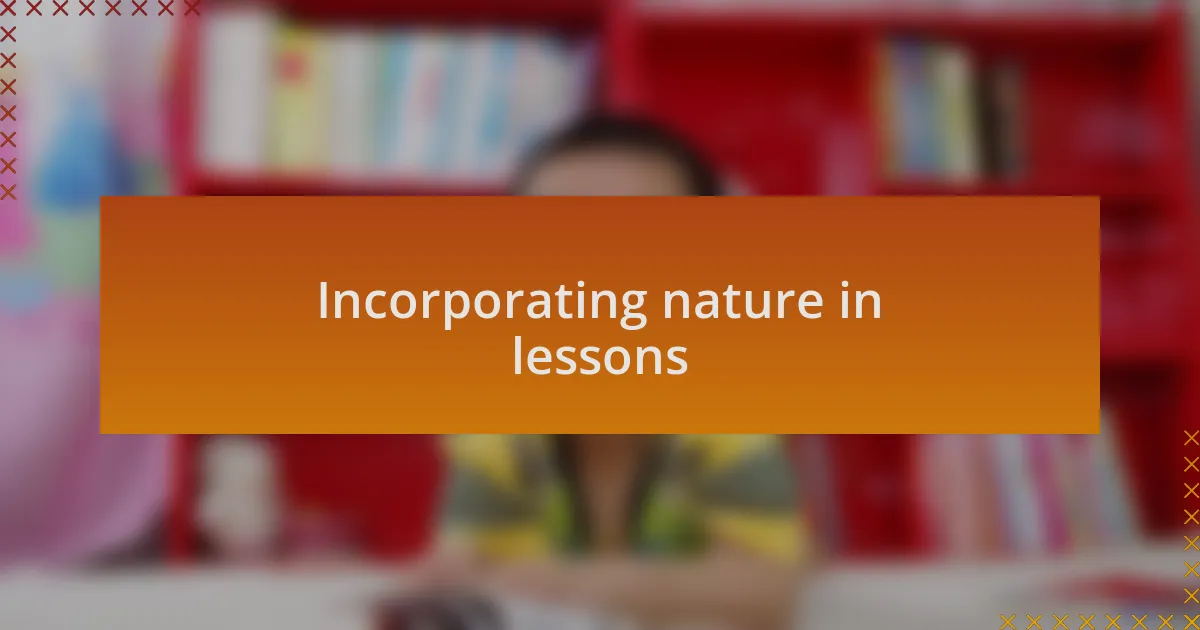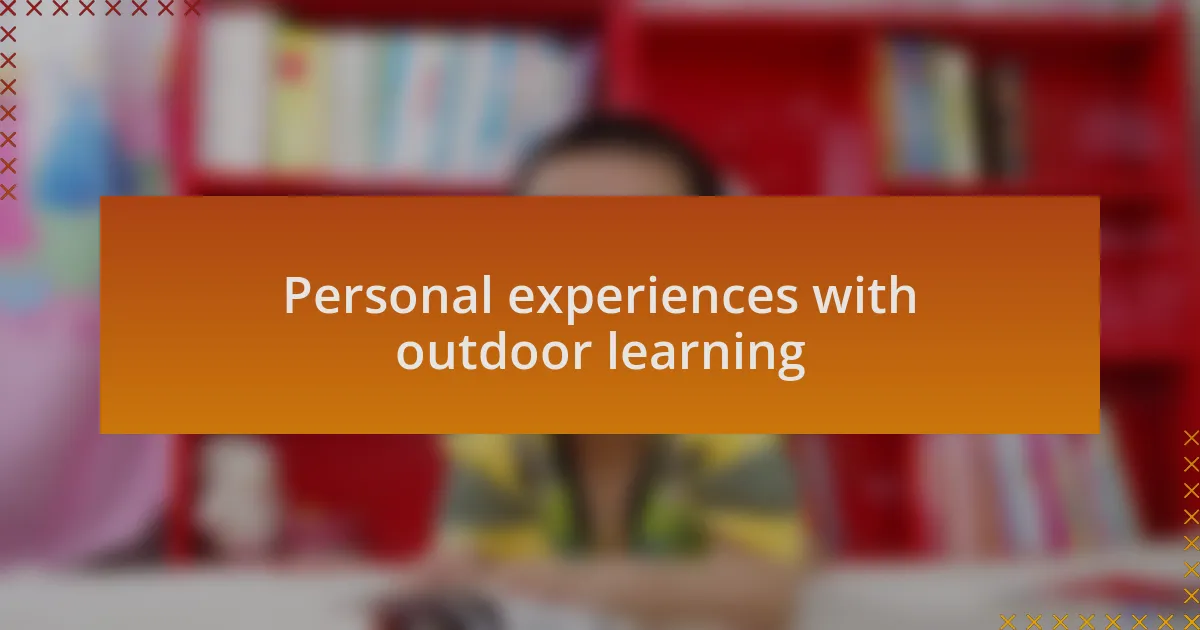Key takeaways:
- Experiential learning bridges theory and practice, fostering critical thinking and environmental responsibility through hands-on experiences.
- Outdoor education promotes physical well-being, teamwork, and social skills, transforming relationships and community spirit among students.
- Effective outdoor activities should align with student interests and curriculum, while also fostering a safe and inclusive environment.
- Nature-related lessons enhance engagement and imagination, making learning memorable and impactful across various subjects.

Understanding experiential learning importance
Experiential learning is essential because it bridges the gap between theory and practice. I still remember the first time I took students outdoors for a science project; the excitement in their eyes as they touched soil and observed insects was palpable. This hands-on experience ignited their curiosity more than any textbook ever could.
When students engage directly with their environment, they learn to think critically—solving real-world problems in real-time. I often ask, how can we expect students to care about the world when they haven’t seen it directly? For me, watching students step into a stream to understand ecosystems underscored how vital firsthand experiences are in nurturing a sense of responsibility for the planet.
Moreover, these learning moments are often tied to deep emotional responses, creating lasting impressions. I recall a student who discovered their love for nature while identifying plants on a hike. It’s in these powerful experiences that students not only grasp knowledge but also build resilience, empathy, and teamwork skills—qualities that are indispensable for their future.

Benefits of outdoor education
Outdoor education offers a multitude of benefits that extend beyond the classroom. I think about the many times I’ve seen students truly connect with nature; they develop a profound respect for the environment when they plant trees or clean local parks. This hands-on involvement not only fosters appreciation but also instills a sense of stewardship that is crucial for their development as conscientious citizens.
Engaging students outdoors also promotes physical well-being. I remember a day when my students enthusiastically participated in a nature scavenger hunt. Seeing them run, jump, and explore not only invigorated their bodies but also sharpened their minds. This kind of physical activity in natural settings can reduce stress and improve focus, making the learning experience even richer.
Importantly, outdoor education cultivates social skills and teamwork. I often recall a group project where students built a birdhouse together. Witnessing their collaboration and communication was incredible; they learned to listen to each other’s ideas and compromise on a design. Isn’t it fascinating how activities outside can transform relationships and foster a community spirit among students?

Strategies for engaging students outdoors
One effective strategy for engaging students outdoors is incorporating hands-on learning experiences that mirror real-world situations. During a recent outdoor science lesson, I vividly remember my students collecting soil samples to analyze different types of minerals. Their excitement as they examined what they found was contagious; it transformed a typically dry subject into an adventure. Have you ever noticed how tangible experiences can suddenly spark a student’s curiosity?
Additionally, integrating storytelling into outdoor activities can foster deeper connections. I organized a story walk where students read pages of a book placed along a trail, which not only combined literacy with exploration but also fostered a sense of community. As they walked together and shared their thoughts, it was clear that the combination of nature and narrative engaged them on an emotional level. Isn’t it intriguing how a change in scenery can elevate the learning experience?
Lastly, I’ve found that allowing students to take the lead in outdoor projects encourages ownership and responsibility. For instance, when my students designed their own garden layouts, they took immense pride in their creations. Watching them plan, collaborate, and ultimately nurture their plants taught them more than just gardening; it instilled a strong sense of accountability. How does giving students autonomy outdoors reshape their learning outcomes in ways traditional classrooms sometimes cannot?

Planning effective outdoor activities
When planning outdoor activities, I’ve learned the importance of aligning them with students’ interests and curriculum goals. For example, while working on a unit about ecosystems, I organized a nature scavenger hunt that featured specific plants and animals relevant to what we were studying. It was fascinating to witness their enthusiasm as they raced to find items and discuss their significance, turning the learning experience into a game.
Moreover, considering logistics is crucial. During an outdoor art project, I underestimated the time needed for preparation, which led to some chaos. However, as my students transformed natural materials into stunning sculptures, their joy outweighed any earlier hiccups. Isn’t it amazing how flexibility can enhance creativity in unexpected ways?
Finally, fostering a safe and inclusive environment is essential to making outdoor activities effective. I remember a moment when a student who typically shied away from group work flourished during a team-building exercise at the park. Encouraging collaboration not only built confidence but also created lasting friendships among the students. Have you ever noticed how a single outdoor moment can shift a student’s perspective on teamwork?

Incorporating nature in lessons
Incorporating nature into lessons can transform the educational landscape for students. One of my most memorable experiences was taking a science class outside to observe the behaviors of local insects. As we examined the intricate details of a buzzing bee, I could see their eyes widen with curiosity, and it struck me how nature fosters a deeper connection to the material. Have you ever witnessed that spark of discovery in a child’s eyes?
Using natural elements in math lessons can be equally impactful. I once introduced geometry by having students sketch trees and measure branches, turning abstract concepts into tangible lessons right in their surroundings. Watching them manipulate tools in nature pushed them to think critically and creatively. Isn’t it fascinating how the outdoors can make learning feel like an adventure rather than a chore?
Additionally, storytelling in nature offers a unique approach to literacy. One day, I encouraged my students to write creative stories inspired by their environment, allowing them to draw from the sights and sounds around them. The narratives they created were vibrant and filled with a deeper sense of place. It made me realize how the context of a lesson can inspire imagination. Have you considered how much richer a child’s story becomes when it’s intertwined with the natural world?

Personal experiences with outdoor learning
One of my most powerful memories of outdoor learning comes from a camping trip with my students. We set up our classroom under the stars one night, and as we explored constellations, I noticed a sense of wonder wash over them. That moment reminded me how learning can transcend textbooks; it can be an immersive experience that connects students to the universe in a profound way. Have you ever felt that sense of awe when gazing at the night sky?
Another unforgettable experience was leading a nature scavenger hunt. I challenged my students to find various plants and animals, and as they raced around, their laughter filled the air. I still recall the joy on their faces when they discovered a hidden nest or identified a unique leaf. This approach taught them to observe their surroundings closely, igniting a curiosity that often only flourishes in nature. Doesn’t it excite you to think about how exploration can fuel a lifelong passion for learning?
Finally, I once integrated a cooking lesson with outdoor learning by foraging for wild herbs nearby. As we collected ingredients, I shared stories about their historical uses, blending practical skills with cultural insights. Watching my students taste the fresh, vibrant flavors was a beautiful reminder of how outdoor experiences can enhance learning beyond the classroom. Have you ever thought about how such experiences can deepen a student’s appreciation for food and culture?

Evaluating the impact on students
Evaluating the impact on students can be profound and multi-faceted. During a project where students restored a local park, I witnessed incredible transformations. They not only grasped ecological principles but also developed teamwork skills, as they had to communicate their ideas and delegate tasks effectively. Have you ever observed how collaboration in a real-world setting can bring out the best in students?
In another instance, after a series of outdoor workshops on team-building activities, I noticed a significant boost in self-confidence among my students. One particularly shy student emerged as a natural leader during a group challenge. Observing that shift was remarkable, as it highlighted how outdoor environments can foster personal growth, encouraging students to step outside their comfort zones. Isn’t it fascinating how a change in scenery can unlock hidden potential?
Additionally, I often reflect on how outdoor learning subtly promotes critical thinking. While navigating a hiking trail as a class, we encountered obstacles that required students to devise creative solutions. I remember one moment when a student proposed an innovative way to get past a fallen tree that ultimately worked for everyone. This experience was not just about physical navigation; it sparked discussions about critical problem-solving skills. Have you ever considered how such scenarios can shape a student’s analytical mindset?